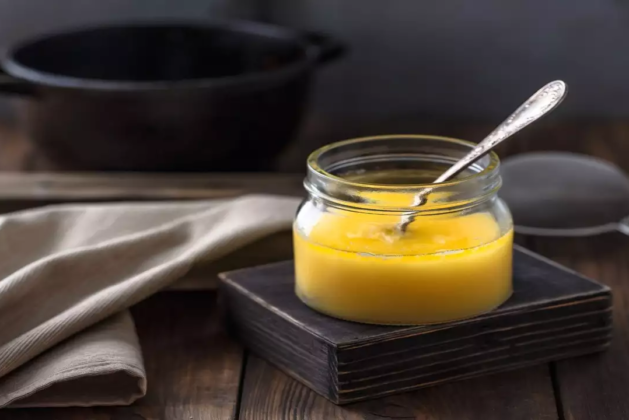Desi ghee, a staple in South Asian cuisine, transcends its role as a cooking fat. It’s a cultural touchstone, a source of rich flavor, and even holds a place in traditional medicine. This golden elixir, clarified butter made from simmered cow’s milk, boasts a unique taste and a surprising amount of health benefits. Let’s delve into the world of desi ghee, exploring its history, production process, culinary applications, and its impact on health.
A History Steeped in Tradition
The origins of desi ghee stretch back millennia, likely originating in ancient India. The Sanskrit word “ghṛta” translates to “clarified,” hinting at the age-old process of separating milk’s fat solids from the watery whey. Early Ayurvedic texts mention ghee’s medicinal properties, highlighting its significance beyond the kitchen. Desi ghee’s journey transcended borders, becoming a cornerstone in Pakistani, Bangladeshi, and other South Asian culinary traditions.
Crafted with Care: The Art of Making Desi Ghee
The magic of desi ghee lies in its simplicity. Traditionally, high-quality whole milk is churned into butter. This butter is then gently simmered over low heat, a process called slow-cooking or clarification. The milk solids separate from the clarified butterfat, rising to the surface as a foamy layer that is skimmed off. The remaining golden liquid is desi ghee, possessing a nutty aroma and a taste that elevates countless dishes.
A Culinary Workhorse: Desi Ghee in the Kitchen
Desi ghee’s high smoke point, around 485°F (250°C), makes it ideal for high-heat cooking methods like stir-frying and deep-frying. It adds a depth of flavor to everything from fluffy rotis and parathas to fragrant curries and rich dals. A touch of desi ghee on rice or vegetables transforms a simple dish into a flavorful culinary experience. In South Asian desserts, desi ghee lends a luxurious texture and a subtle nutty note to sweets like barfi and ladoos.
Beyond Flavor: The Potential Health Benefits of Desi Ghee
Desi ghee has been a part of traditional medicine for centuries. While modern research doesn’t always support these claims definitively, some potential health benefits are worth exploring. Desi ghee is a good source of healthy fats, including conjugated linoleic acid (CLA) and butyric acid, which may contribute to gut health and heart health. It’s also rich in fat-soluble vitamins A, D, E, and K, essential for various bodily functions. However, it’s important to remember that desi ghee is still high in calories and saturated fat, so moderation is key.
Choosing the Perfect Desi Ghee
With a growing awareness of desi ghee’s culinary and potential health benefits, the market offers a wide variety of options. Look for brands that use high-quality milk from grass-fed cows. Opt for desi ghee that is a deep golden color and has a pleasant, nutty aroma. Avoid ghee that is overly processed or has a strong burnt smell.
Storing Desi Ghee: A Timeless Tradition
Desi ghee’s beauty lies in its long shelf life. Traditionally, desi ghee was stored in airtight containers at room temperature, lasting for months or even years. Due to modern hygiene concerns, refrigeration is recommended, where it can stay fresh for up to a year. Ghee stored at room temperature may develop a slightly stronger flavor, but it’s still perfectly safe to consume.
Desi Ghee: More Than Just Cooking Fat
Desi ghee is a cultural icon, a culinary treasure, and a potential source of health benefits. Its rich history, meticulous production process, and versatility in the kitchen solidify its place as a cornerstone of South Asian cuisine. So, the next time you reach for cooking oil, consider the golden goodness of desi ghee. It might just elevate your culinary creations to a whole new level.




Leave a comment